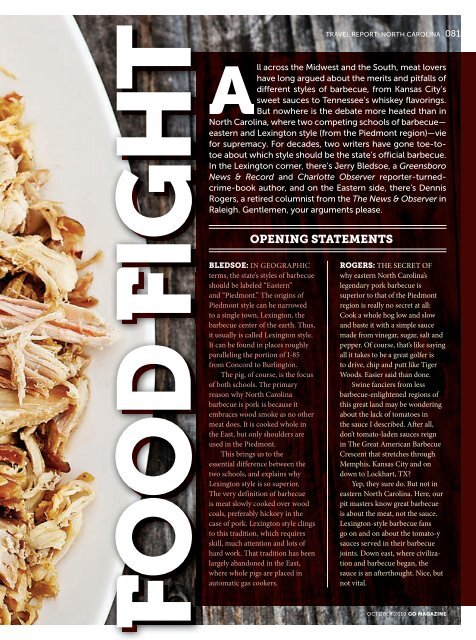You also want an ePaper? Increase the reach of your titles
YUMPU automatically turns print PDFs into web optimized ePapers that Google loves.
FOOD FIGHT<br />
TRAVEL REPORT: NORTH CAROLINA<br />
All across the Midwest and the South, meat lovers<br />
have long argued about the merits and pitfalls of<br />
different styles of barbecue, from Kansas City’s<br />
sweet sauces to Tennessee’s whiskey flavorings.<br />
But nowhere is the debate more heated than in<br />
North Carolina, where two competing schools of barbecue—<br />
eastern and Lexington style (from the Piedmont region)—vie<br />
for supremacy. For decades, two writers have gone toe-totoe<br />
about which style should be the state’s official barbecue.<br />
In the Lexington corner, there’s Jerry Bledsoe, a Greensboro<br />
News & Record and Charlotte Observer reporter-turnedcrime-book<br />
author, and on the Eastern side, there’s Dennis<br />
Rogers, a retired columnist from the The News & Observer in<br />
Raleigh. Gentlemen, your arguments please.<br />
OPENING STATEMENTS<br />
BLEDSOE: IN GEOGRAPHIC<br />
terms, the state’s styles of barbecue<br />
should be labeled “Eastern”<br />
and “Piedmont.” The origins of<br />
Piedmont style can be narrowed<br />
to a single town, Lexington, the<br />
barbecue center of the earth. Thus,<br />
it usually is called Lexington style.<br />
It can be found in places roughly<br />
paralleling the portion of I-85<br />
from Concord to Burlington.<br />
The pig, of course, is the focus<br />
of both schools. The primary<br />
reason why North Carolina<br />
barbecue is pork is because it<br />
embraces wood smoke as no other<br />
meat does. It is cooked whole in<br />
the East, but only shoulders are<br />
used in the Piedmont.<br />
This brings us to the<br />
essential difference between the<br />
two schools, and explains why<br />
Lexington style is so superior.<br />
The very definition of barbecue<br />
is meat slowly cooked over wood<br />
coals, preferably hickory in the<br />
case of pork. Lexington style clings<br />
to this tradition, which requires<br />
skill, much attention and lots of<br />
hard work. That tradition has been<br />
largely abandoned in the East,<br />
where whole pigs are placed in<br />
automatic gas cookers.<br />
ROGERS: THE SECRET OF<br />
why eastern North Carolina’s<br />
legendary pork barbecue is<br />
superior to that of the Piedmont<br />
region is really no secret at all:<br />
Cook a whole hog low and slow<br />
and baste it with a simple sauce<br />
made from vinegar, sugar, salt and<br />
pepper. Of course, that’s like saying<br />
all it takes to be a great golfer is<br />
to drive, chip and putt like Tiger<br />
Woods. Easier said than done.<br />
Swine fanciers from less<br />
barbecue-enlightened regions of<br />
this great land may be wondering<br />
about the lack of tomatoes in<br />
the sauce I described. After all,<br />
don’t tomato-laden sauces reign<br />
in The Great American Barbecue<br />
Crescent that stretches through<br />
Memphis, Kansas City and on<br />
down to Lockhart, TX?<br />
Yep, they sure do. But not in<br />
eastern North Carolina. Here, our<br />
pit masters know great barbecue<br />
is about the meat, not the sauce.<br />
Lexington-style barbecue fans<br />
go on and on about the tomato-y<br />
sauces served in their barbecue<br />
joints. Down east, where civilization<br />
and barbecue began, the<br />
sauce is an afterthought. Nice, but<br />
not vital.<br />
OCTOBER <strong>2010</strong> GO MAGAZINE<br />
081
















